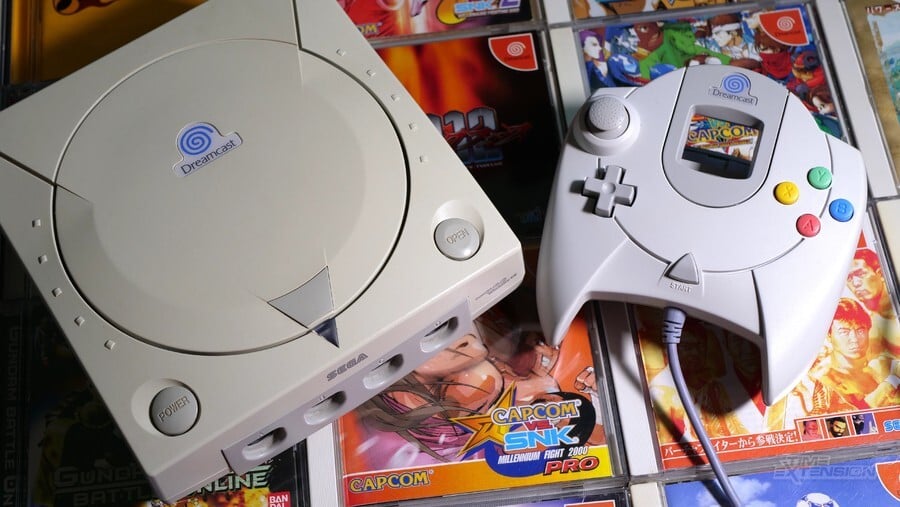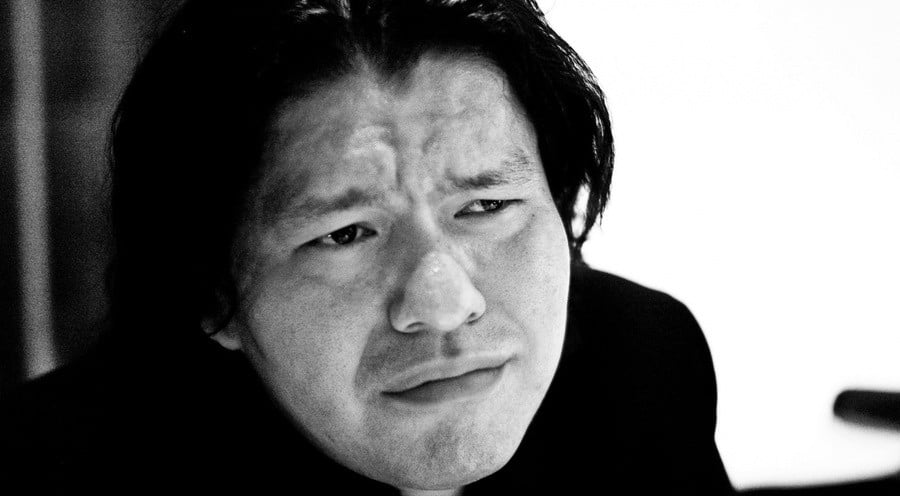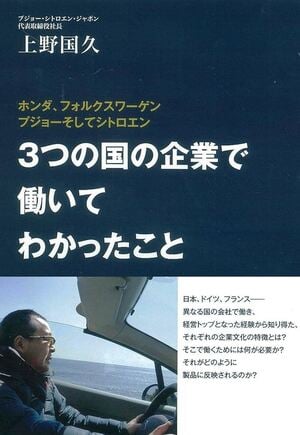
Don't worry – you're not suffering from déjà vu. If you feel like you've read this before, it's because we're republishing some of our favourite features from the past year as part of our Best of 2024 celebrations. If this is new to you, then enjoy reading it for the first time! This piece was originally published on January 15th, 2024.
Who created Dreamcast's logo? You'd think that would be a simple thing to answer.
After all, Sega's shop is still full of Dreamcast-associated merch emblazoned with the iconic coloured swirl and there have been countless interviews over the years with people involved in the system's launch — how hard could it be? But when we started looking into the topic over a year ago, it quickly became apparent to us that Sega has never officially revealed who was responsible and that there are a ton of conflicting reports online over the nature of its creation with some sources suggesting the game developer Kenji Eno was behind the design, while others claim the consultancy firm Interbrand played a role. This made us want to dig deeper to see whether we could get to the bottom of these inconsistencies, so over the past year, we decided to use every trick up our sleeve to find out the truth of the matter.
We've reached out to former Sega employees, current Sega employees, Sega's PR (who sadly didn't return any of our emails), and combed endlessly through Japanese websites and historical documents. We've also contacted other researchers and journalists just to leave no stone unturned and hit multiple speed bumps and dead ends along the way. Now, though, we're glad to say we have a much greater understanding of how it came to be, with the answer lying hidden in the unlikeliest of places.
When we first set out to write about the origins of the Dreamcast logo, we started looking in the most obvious of places: google. This immediately threw up a Wikipedia entry claiming that Kenji Eno was the person behind the swirl, with the citation linking to an interview that the Time Extension contributor John Szczepaniak had previously done with the musician Katsutoshi Eguchi for his book The Untold History of Japanese Game Developers: Volume 1.

In that interview, Szczepaniak spoke to Eguchi about his friend Kenji Eno, asking him "Do you know any other trivia about Kenji Eno?". Eguchi then replied that Eno had been the one responsible for the Dreamcast name and logo, before recounting a story that the video game developer had reportedly told him before his passing in 2013:
“Sega accepted open submissions from the general public for their new console’s name and logo. Eno-san posed as just a regular entrant, and he did it. He won it. Over a thousand entries and he won it. He said it. Whether or not it’s true I don’t know. But Eno-san said, ‘I came up with it,’ so it’s probably true. I think it was open for everybody. I think anyone could enter… Maybe it was industry, I’m not exactly sure. But there was something like 1000 ideas and if what he was saying was true, then Eno-san’s entry was the winner."
As much as we'd love to accept this at face value and call the search off, Eguchi claims twice in the story that he doesn't know whether this is actually true or not. This would mean that we'd need to find another corroborating source before we'd be able to give up the hunt. So we did some more digging and eventually came across an entry on Sega Retro linking to an issue of Edge Magazine from Christmas 2001 where it claimed Sega had hired a branding company called Interbrand to come up with the Dreamcast name.

This article stated that Interbrand came up with the name "Dreamcast" after going through 5000 other alternatives, but there's no mention of the logo anywhere in the piece, so again, we couldn't hang up our detective's hat just yet.
Instead, we turned our attention to asking former Sega employees about the logo to see what they could remember, hoping that it would shine a light on the mystery.
Among the first people we decided to contact was Peter Moore, who was the senior vice president of marketing in 1999 at the time of the Dreamcast's North American launch, before becoming Sega of America president in May 2000.
We hoped that he might have some insider knowledge of who was responsible having worked in Sega of America's marketing department, but sadly he told us "It was always a mystery and no one seems to have a definitive answer other than that Sega of Japan’s marketing company came up with it in 1998."
Besides Moore, another person we believed might have an insight into the topic was Lee McEnany Caraher, a former vice president of corporate & consumer communications at Sega of America, who had been at the company around the Saturn and Dreamcast era.
We presented them with everything we'd read about the logo elsewhere, but again, they couldn't provide us with anything conclusive: "I remember that it was a combination of name/font from one design and the icon from another... Interbrand sounds right but if I recall correctly, the final was not their recommendation, but a combination of parts from different recommendations — I'm sure the approval happened in Japan with strong recommendations from Bernie Stolar [former Sega of America president]. Sorry, I can't be more definitive."
With Stolar having sadly having passed away in 2022, it seemed clear from the above that, to get answers, we'd need to speak to someone who worked at Sega of Japan during the Dreamcast days. So we tracked down contacts for various Sega of Japan employees past and present.
As part of this process, we did get a few replies from former Sega staff members, but none of them seemed happy to speak to us without Sega's express approval, and unfortunately, Sega's PR was unresponsive to our requests to arrange any official interviews. It was at this point that we started to get fairly desperate and began trawling the Japanese web to see whether the information was already out there but simply locked away behind a language barrier, and eventually, we got some results.
The first article we managed to dig up was published by ITMedia in May 1998, five months before the Dreamcast's launch in Japan. It didn't include the name of the logo's author but notably featured a quote in Japanese from (then) Sega president Shoichiro Irimajiri, who claimed that the symbol "is meant to evoke the vastness of space or the unlimited potential of humans" (thanks Liz Bushouse for the translation!).

The second, meanwhile, was published significantly later on and was a Japanese blog summarizing a 2015 book (Honda, Volkswagen, Peugeot, and Citroen: What I have learned from working for companies in three different countries) from the Peugeot Japan president, Kunihisa Ueno, where the executive reflected on his time at Sega.
Kunihisa Ueno is a figure that we must admit we weren't already familiar with before looking into this topic but was responsible for the marketing of both the Sega Saturn and Sega Dreamcast in Japan, in addition to games like Christmas NiGHTS into Dreams, Sonic Adventure, and Shenmue. He joined Sega in 1995 from Honda, after Irimajiri (another ex-Honda employee) invited him and a number of his former colleagues to join the company, and seemed to know all the answers we'd been looking for.
In the excerpts shared in the blog, Ueno explains that Interbrand was originally tasked with coming up with the name of Sega's next console, but one day, while speaking to Eno, he accidentally let slip that the name hadn't yet been decided on, causing the game developer to volunteer his help.
Eno immediately began thinking of possible names, eventually pitching them the name "Dreamcast", which Sega loved. However, Sega was worried that having a celebrity developer like Eno attached to the console's name would create the wrong impression and that the new hardware would need to be for all creators. Ueno, therefore, recalls Sega paying Eno some money, before having him sign an NDA to prevent his involvement from becoming public.
After that, Ueno then approached Interbrand again to come up with a logo based on the "Dreamcast" name, resulting in the finished logo that we know and love today.
Suddenly, with this information, everything seemed to click into place, with Ueno's account explaining the nature of Interbrand's and Eno's involvement. Of course, the next step is to try and see whether we can track down the Interbrand employee who was responsible for designing the logo, but that is a mission for another day.
